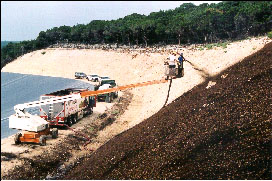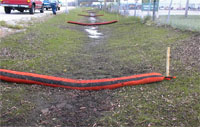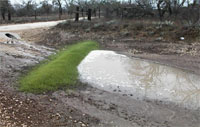What are the Compost Best Management Practices?
What are the Compost BMPs?
The compost BMPs consist of three methods to use compost to improve water quality by reducing the amount of stormwater that can enter waterways by increasing the amount of water that can infiltrate into the soil by creating barriers that stop the water from flowing or cover the soil completely. For details on how the compost BMPs work and what they can do See Dr. Britt Faucette's video.

- Use on any soil surface (e.g., road embankments and construction sites) on slopes between 4:1 and 1:1.
- For steeper slopes (1:1), use compost that is designed for this purpose and install in conjunction with netting or another confinement system
A compost filter sock is a mesh tube filled with compost that is placed perpendicular to sheet flow runoff to control erosion and retain sediment in disturbed areas. The filter sock can be used in place of a sediment and erosion control tool such as a silt fence.

- Use along the perimeter of a site or at intervals along a slope to treat sheet flow runoff. In areas of concentrated flow, place sock in an inverted V going up the slope to reduce the velocity of runoff.
- Filter socks can be moved and are especially useful on steep or rocky slopes.
- No trenching is required during installation; therefore, socks can be used on pavement as inlet protection for storm drains.

A compost filter berm is a dike of compost that is placed perpendicular to sheet flow runoff to control erosion in disturbed areas and retain sediment. It can be used in place of a sediment and erosion control tool such as a silt fence. The base of the berm is generally twice the height of the berm. Click here for a link to the NPDES BMP for compost berms
- Place along the perimeter of a site or at intervals along a slope to capture and treat runoff. Not suitable for areas with concentrated runoff, unless the drainage is small and the flow rate is low.
- No trenching is required for installation; therefore, berms can be installed on frozen or rocky ground.
All videos on this page courtesy of Dr. Tom Glanville, Iowa State University
![[logo] US EPA](../gif/logo_epaseal.gif)